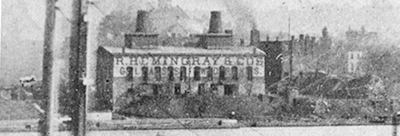Archaeological remains were linked to both factories. They consisted of building foundations, kilns, ovens, cisterns, privies, and trash pits.
Many of the artifacts were associated with glassware manufacturing. Analysis of glass manufacturing by-products and rejects revealed that the Hemingray Glass factory produced beer and mineral water bottles, oil lamp chimneys, fruit jars, flasks, fish globes, and tableware.
The Company also was one of the largest U.S. manufacturers of electric and telegraph insulators. The large amounts of glass slag revealed that the factory made products in a variety of colors: clear, aqua, blue, amber, amethyst, white, black, and several shades of green.
